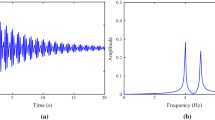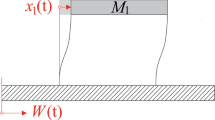Abstract
The identification of modal parameters from the response data only is studied for structural systems under nonstationary ambient vibration. In a previous paper by the authors, the modal parameters of a system were identified using the correlation method in conjunction with the curve-fitting technique. This was done by working within the assumption that the ambient excitation is a nonstationary white noise in the form of a product model. In the present paper, the Ibrahim time-domain method (ITD) is extended for modal-parameter identification from the nonstationary ambient response data without any additional treatment of converting the original data into the form of free vibration. The ambient responses corresponding to various nonstationary inputs can be approximately expressed as a sum of exponential functions. In effect, the ITD method can be used in conjunction with the channel-expansion technique to identify the major modes of a structural system. To distinguish the structural modes from the non-structural modes, the concept of mode -shape coherence and confidence factor is employed. Numerical simulations, including one example of using the practical excitation data, confirm the validity and robustness of the proposed method for identification of modal parameters from the nonstationary ambient response.
Similar content being viewed by others
References
C. E. Ventura, W. D. Liam-Finn, J.-F. Lord and N. Fujita, Dynamic characteristics of a base isolated building from ambient vibration measurements and low level earthquake shaking, Soil Dynamics and Earthquake Engineering, 23(4) (2003) 313–322.
W.-X. Ren, W. Zatar and I. E. Harik, Ambient vibrationbased seismic evaluation of a continuous girder bridge, engineering structures, 26(5) (2004) 631–640.
J. L. Beck, B. S. May and D. C. Polidori, Determination of modal parameters from ambient vibration data for structural health monitoring, First World Conference on Structural Control, 2, International Association for Structural Control, Los Angeles, Aug. 1994, pp. TA3-3–TA3-12.
C. E. Ventura, N. D. Schuster and A. J. Feiber, Ambient vibration testing of a 32-storey reinforced concrete building during construction, Proceedings of the 13 th International Model Analysis Conference, Society for Experimental Mechanics, Bethel, CT (1995) 1164–1170.
J. C. Asmussen, S. R. Ibrahim and R. Brincker, Random decrement and regression analysis of bridges traffic responses, Proceedings of the 14th International Modal Analysis Conference, 1 (1996) 453–458.
S. R. Ibrahim and E. C. Mikulcik, A method for the direct identification of vibration parameters from free response, Shock and Vibration Bulletin, 47(4) (1977) 183–198.
G. H. James, T. G. Carne and J. P. Lauffer, The natural excitation technique for modal parameter extraction from operating wind turbines, SAND92-1666. UC-261, Sandia National Laboratories, 1993.
D. Y. Chiang and M. S. Cheng, Modal parameter identification from ambient response, AIAA Journal, 37 (1999) 513–515.
D. Y. Chiang and C. S. Lin, Identification of modal parameters from ambient vibration data using eigensystem realization algorithm with correlation technique, Journal of Mechanical Science and Technology, 24(12) (2010) 2377–2382.
D. Y. Chiang and C. S. Lin, Identification of modal parameters from non-stationary ambient vibration data using correlation technique, AIAA Journal, 46(11) (2008) 2752–2759.
S. R. Ibrahim, Modal confidence factor in vibration testing, Journal of Spacecraft and Rockets, 15(5) (1978) 313–316.
Y. Gao and R. B. Randall, The ITD mode-shape coherence and confidence factor and its application to separating eigenvalue positions in the Z-plane, Mechanical Systems and Signal Processing, 14(2) (2000) 167–180.
M. Shinozuka, Simulation of multivariate and multidimensional random processes, Journal of the Acoustical Society of America, 49(1) (1971) 357–367.
T. C. Hsia, Least-squares theory, System Identification: Least-Squares Methods, Lexington Books, Lexington, Massachusetts (1977) 17–32.
R. L. Allemang and D. L. Brown, A correlation coefficient for modal vector analysis, Proceedings of the 1st International Modal Analysis Conference, Society for Experiment Mechanics, Bethel, CT (1983) 110–116.
Author information
Authors and Affiliations
Corresponding author
Additional information
This paper was recommended for publication in revised form by Associate Editor Ohseop Song
D. Y. Chiang received his Ph.D. in Applied Mechanics from the California Institute of Technology, USA in 1992. He joined the faculty of National Cheng Kung University, Taiwan in 1993 where he is currently a professor at the Department of Aeronautics and Astronautics. His research interests are system identification and plasticity.
C. S. Lin received his B.S. and M.S. degrees from the Department of Aeronautics and Astronautics of National Cheng Kung University, Taiwan in 2002 and 2004, respectively. He is currently a Ph.D. candidate with research interests in random vibration and modal analysis.
Rights and permissions
About this article
Cite this article
Chiang, DY., Lin, CS. Identification of modal parameters from nonstationary ambient vibration data using the channel-expansion technique. J Mech Sci Technol 25, 1307 (2011). https://doi.org/10.1007/s12206-011-0229-y
Received:
Revised:
Accepted:
Published:
DOI: https://doi.org/10.1007/s12206-011-0229-y




